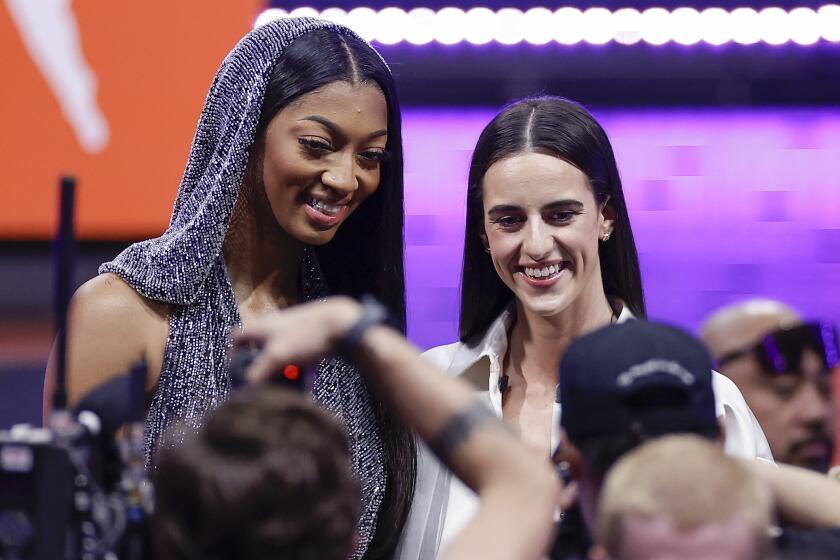The case of Caster Semenya
Magazine or TV makeovers are frequently as queasy-making as they are jaw-dropping. Whether the transformation involves weight loss, a new haircut, wardrobe, nose, or some combination thereof, the end result might have you going back to the “before” picture and wondering if more harm than good has been done.
This was exactly the case last week when South Africa’s You magazine featured a cover story about Caster Semenya, the 18-year-old South African middle-distance runner who won the women’s 800 meters in the World Championships in Berlin last month by an astonishing 2.45 seconds. Semenya immediately fell under gender scrutiny amid reports of her elevated testosterone levels and the aggrieved charges of fellow runners. Is she a man or a woman, race officials and the public wondered, as Semenya, under the orders of the International Assn. of Athletics Federation, began a series of gender tests. In the meantime, You magazine dressed her in stilettos, applied many layers of makeup and attributed to her such quotes as, “Now that I know what I can look like, I’d like to dress like this more often” and “I’d also like to learn to do my own makeup.”
The test results were leaked to the media last week, and they showed Semenya is actually intersex, meaning she has both male and female characteristics. Newspaper reports said she has internal testicles and lacks ovaries or a uterus. Semenya disappeared from public view and withdrew from a race she was scheduled to run last weekend. Meanwhile, IAAF officials are deciding whether she should be stripped of her title because her natural testosterone levels might afford her an unfair advantage in the women’s competition.
Intersex conditions exist on a spectrum, with some people possessing obvious physical characteristics of both genders and others so apparently “normal” that they’re not even aware of their condition (which appears to have been the case with Semenya, despite her deep voice and other masculine cues). As many questions as Semenya’s case raises within the arena of athletics (and hers is not the first such case; in 2006, an intersex runner from India was stripped of a medal and later attempted suicide), it poses even more about maleness and femaleness in general.
Society, in large part, has grown accustomed to thinking about race, religion and even sexual identity in more than just binary terms -- recognizing that people may be black and white, Catholic and Buddhist, even transgender -- but being both sexes at once?
As it happens, however, Semenya’s condition is hardly unheard of. According to data from the Intersex Society of North America, the number of people “whose bodies differ from standard male or female” account for one in 100 births, and babies that get surgery “to ‘normalize’ genital appearance” account for one or two in every 1,000 births. Some have speculated that Semenya’s particular condition is something called partial androgen insensitivity syndrome, which occurs in one of every 130,000 births. You do the math: In its most common form, being born intersex is rare but not vanishingly rare; by some measures, it’s on the order of being born with red hair.
But that doesn’t make Semenya’s case any less troubling, poignant or compelling. Maybe that’s because it reinforces gender stereotypes even as it appears to defy them. For those who champion women’s potential and their equality with men, it was exciting to see the powerful Semenya win a race by a wide margin. But to learn that this woman won -- for lack of a better way of putting it -- because she competed at least partly on male terms sours the whole experience. It seems unfair to the other female runners, and worse, it forces a recognition of the irreducible fact that male hormones make you more physically powerful than female ones.
This may be obvious -- and let’s be reasonable, it’s not anything to get terribly upset over -- but there is something oddly deflating about being reminded once again just how unequal the sexes can be. Through no fault of her own -- and clearly the athlete herself didn’t set out to deceive anyone -- Semenya performed a bait and switch. She made us think we were looking at a superwoman, only to learn later that her superness was dependent on a significant measure of masculinity. And her handlers, instead of giving the public time to digest the truth, exacerbated the feelings of betrayal by allowing her to be put on a magazine cover looking like a caricature of femininity.
In so doing, an athlete who had started to open people’s eyes caused many to turn away in embarrassment. If I were Semenya, I wouldn’t be planning to wear stilettos more often. I’d be getting ready to throw them.
More to Read
Go beyond the scoreboard
Get the latest on L.A.'s teams in the daily Sports Report newsletter.
You may occasionally receive promotional content from the Los Angeles Times.











